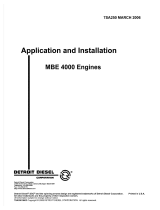
Turn off motor. The motor is to remain off during the entire installation period.
Remove the original fan shroud. In some cases, the fan will also have to be removed.
If the fan was removed, reinstall it at this time.
Position the Trans-Dapt Performance shroud on your radiator. Allow at least 1” clearance
between the shroud and the circumference of the fan.
Insert one of the plastic screws from the front of the radiator, between the radiator cores so that it
extends through the radiator and a tab on the fan shroud. Spin on a wing nut and secure it
loosely. If the top of the radiator can extend down below the radiator cores, it may require the
use of the rubber washers between the radiator core and the shroud, so that the shroud is
parallel to the radiator surface.
Recheck the clearance between the fan and the shroud.
Install the remaining three plastic screws & hardware into the other three tabs in the fan shroud.
Recheck for clearance between the fan and the fan shroud by manually turning the fan.
If the fan shroud is positioned correctly, tighten all mounting hardware.
If you removed & reinstalled the fan, check the fan bolts to see that they are secured tightly.
Check for hood clearance before closing the hood.
1.
2.
3.
4.
5.
6.
7.
8.
9.
10.
11.
This fan shroud is not designed to
provide support for the radiator
itself. If the original fan shroud
does provide support for the
radiator, we do not recommend
the use of this fan shroud.
IMPORTANT
WING NUT RUBBER
WASHER
PLASTIC
SCREWS
DAPT
DAPTDAPTDAPT
PERFORMANCE PRODUCTS
PART# 9453 & 9454
FAN SHROUD
INSTALLATION INSTRUCTIONS
9453-ins-111406.cdr
12438 Putnam Street Whittier, CA 90602 tel (562) 921-0404 fax (562) 921-7515
/








